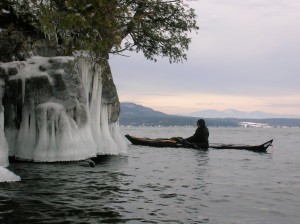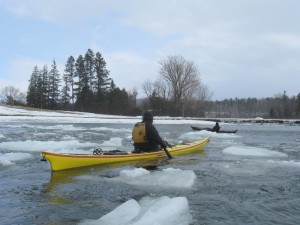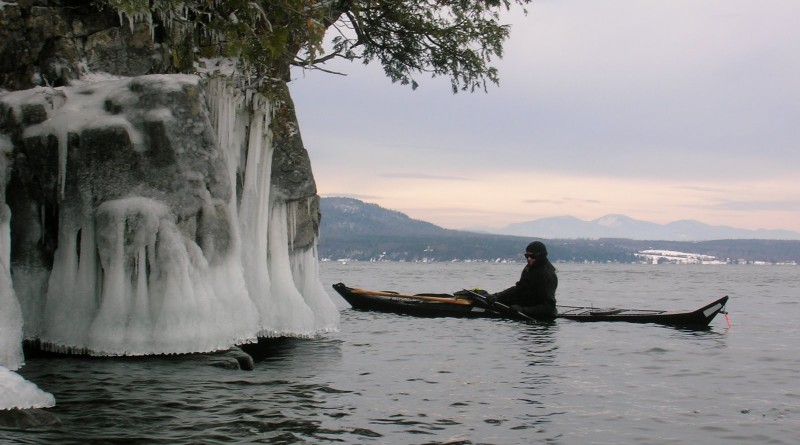(Dry) Suit Yourself | Cold-Weather Paddling Is Fun, But Not for Everyone

It’s November. Time to put away the paddles and take out the skis, right?
Not necessarily. As long as bodies of water still are in liquid form, there’s no reason why you can’t head out on a lake or river if you take proper precautions. There are a surprising number of locals who don’t let a little snow and ice end their paddling season.
One of the most important considerations is how you dress.
The Champlain Kayak Club’s website suggests using wetsuits if the water temperature is above 50, but when the water is colder, switching to a drysuit with latex gaskets at the neck and wrists, and either additional gaskets at the ankles or attached booties. The drysuit should be worn over a layer of fleece or polypropylene. Additionally, the club recommends a neoprene wind-proof head covering; gloves and boots, and strongly suggests all cold-water kayakers carry a change of clothing in a dry bag kept inside their boat and monitor each other for signs of hypothermia.
Tony Shaw, of Williston, once paddled every month of the year in his canoe, so he has plenty of experience in the cold. He used to paddle in just a wetsuit, but eventually broke down and purchased a drysuit for the colder months, adding neoprene booties and gloves, and a skull cap under his helmet.
Don Perley, a kayaker from Burlington, routinely kayaks every month of the year, usually on Lake Champlain. Despite having gone out in air temperatures as low as zero, Perley doesn’t think kayaking feels any colder than skiing. “You’re out in the same temperature and wearing the same kind of clothing,” he said.
 Perley’s favorite cold-water accessory is a neoprene hooded sweatshirt called a tuiliq, the bottom hem of which attaches to the cockpit rim, so it serves as both a layer of clothing and a spray skirt. Perley uses a Greenland paddle (designed for easier rolling), so pogies (a type of glove that attaches to regular paddles) are not an option. He finds neoprene mittens sufficient to keep his hands warm. In addition, he wears knee-high neoprene boots.
Perley’s favorite cold-water accessory is a neoprene hooded sweatshirt called a tuiliq, the bottom hem of which attaches to the cockpit rim, so it serves as both a layer of clothing and a spray skirt. Perley uses a Greenland paddle (designed for easier rolling), so pogies (a type of glove that attaches to regular paddles) are not an option. He finds neoprene mittens sufficient to keep his hands warm. In addition, he wears knee-high neoprene boots.
Another consideration is post-paddle clothing. Kayakers with dry storage can keep clothing in the boat, but given the open nature of the canoe, Shaw generally keeps a change of clothes in the car. However, in the event of an unintentional swim, this choice can prove problematic. One day before he bought his drysuit, Shaw “swam” in the White River. He and his buddy hitchhiked back to Sharon in soaking wet clothing.
“It wasn’t a glorious event,” he said, “but we made it back.”
These days, to minimize risk, Shaw often leaves a car—and clothes—midway on the course he plans to run, as well as at his destination.
 As far as gear, items such as pumps, water bottles, and ropes are kept inside a kayak’s cockpit to keep them from freezing. Greenland paddles are an excellent option, but for those who don’t want to use them, Craig Richardson of Umiak Outdoor Outfitters in Stowe recommends a foam paddle float that saves time after an unintentional wet exit, because it doesn’t have to be inflated.
As far as gear, items such as pumps, water bottles, and ropes are kept inside a kayak’s cockpit to keep them from freezing. Greenland paddles are an excellent option, but for those who don’t want to use them, Craig Richardson of Umiak Outdoor Outfitters in Stowe recommends a foam paddle float that saves time after an unintentional wet exit, because it doesn’t have to be inflated.
Staying Safe on the Water
Once you’ve prepared your wardrobe, there are additional challenges associated with whitewater paddling in cold water, particularly in open boats. A major safety concern, Shaw said, is ice shelves, which can persist in eddies below the surface of turbid high water, and may not be visible. Other, more mundane worries are the “ice cream headaches” paddlers get after flipping in cold water.
In colder weather, Shaw said he is more likely to go out on smaller streams because it’s easier to reach the bank. He recalled a day on the lower Lamoille River in a tandem canoe when he and his partner ended up on opposite sides of the river.
“I remember, as we were floating downstream, trying to yell to him,” he said, “but I could barely speak because the cold water took my breath away.”
Another day, Shaw and his friends had planned to canoe on the New Haven River. As they stepped out of their cars, they realized the river was rising out of its banks into the woods.
“The water came up three feet in the course of a few minutes,” Shaw said. “It was filled with slush and dinner plate sized chunks of ice. If we’d been in the water, I shudder to think what might have happened.”
Don Perley apologized for not having a single horror story about cold-water paddling. For him, the activity is fairly mundane. The worst thing he has experienced is the time he could not get off his personal flotation device because the zipper froze: on one 10-degree day, he had to drive home wearing it over his drysuit because even in the car, the zipper refused to budge. It wasn’t until he got home and sprayed the zipper with warm water that he was finally able to change.
Generally, when Perley and his friends head out in winter, one member of the party scouts the lake the day before to see where the open water is accessible by shore. The group manages almost weekly excursions during the winter months, doing as much as 10 miles a day and only skipping those days when snowfall interferes with driving. Sometimes, there is a layer of ice close to shore, but the members of the group simply push their boats across the ice until they reach the edge.
On winter excursions, these paddlers rarely exit the boats, opting to eat in their watercrafts, sometimes after propelling themselves up onto a sheet of ice.
Although some kayakers paddle alone in the winter months, Perley does not recommend doing so. He only goes out with other kayakers who are capable of performing a full roll. The group makes a habit of practicing their rolls each time they head out; even in January. Often they will do a roll right before exiting the lake in order to expose their zippers to the water, which is warmer than the air, making it easier to remove articles of clothing for the drive home. The coldest part of the trip, Perley said, is at the end of the day when he and his paddling partners have to take their mittens off to put their boats back on their cars.
Umiak’s Richardson recalls a customer who told him about his mid-winter excursions on Lake Champlain. The man ties a rope to a tree and pulls the other end of the rope with him across the ice. He uses ice axes to propel himself across the ice until he finds open water, and then tucks the axes into the boat. On the way back he repeats the process, and uses the rope to pull himself to shore.
Admittedly, this sport is not for everyone.
As Richardson puts it, “I’d rather be skiing.”

